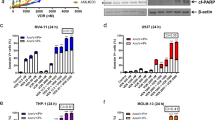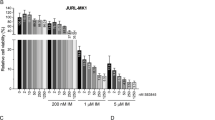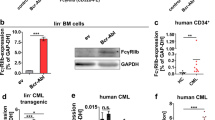Abstract
Recent studies indicate that a rare population of primitive quiescent BCR-ABL+ cells are innately insensitive to imatinib mesylate (IM) and persist after IM therapy of patients with chronic myeloid leukemia (CML). New approaches to the eradication of these cells are therefore likely to be crucial to the development of curative therapies for CML. We have now found that Ara-C, LY294002 (a PI-3 (phosphatidylinositol-3′ kinase) kinase inhibitor), 17AAG (a heat-shock protein (HSP)-90 antagonist) and lonafarnib (a farnesyltransfease inhibitor) all enhance the toxicity of IM on K562 cells and on the total CD34+ leukemic cell population from chronic phase CML patients. However, for quiescent CD34+ leukemic cells, this was achieved only by concomitant exposure of the cells to lonafarnib. Ara-C or LY294002 alone blocked the proliferation of these cells but did not kill them, and Ara-C, LY294002 or 17AAG in combination with IM enhanced the cytostatic effect of IM but did not prevent the subsequent regrowth of the surviving leukemic cells. These studies demonstrate the importance of in vitro testing of novel agents on the subset of primary leukemic cells most likely to determine long-term treatment outcomes in vivo.
This is a preview of subscription content, access via your institution
Access options
Subscribe to this journal
Receive 12 print issues and online access
$259.00 per year
only $21.58 per issue
Buy this article
- Purchase on Springer Link
- Instant access to full article PDF
Prices may be subject to local taxes which are calculated during checkout




Similar content being viewed by others
References
O'Brien SG, Guilhot F, Larson RA, Gathmann I, Baccarani M, Cervantes F et al. Imatinib compared with Interferon and low-dose cytarabine for newly diagnosed chronic-phase chronic myeloid leukemia. N Engl J Med 2003; 348: 994–1004.
Hahn EA, Glendenning GA, Sorensen MV, Hudgens SA, Druker BJ, Guilhot F, et al., IRIS Investigators. Quality of life in patients with newly diagnosed chronic phase chronic myeloid leukemia on imatinib versus interferon alfa plus low-dose cytarabine: results from the IRIS study. J Clin Oncol 2003; 21: 2138–2146.
Hughes TP, Kaeda J, Branford S, Rudzki Z, Hochhaus A, Hensley ML et al. Frequency of major molecular responses to imatinib or interferon alfa plus cytarabine in newly diagnosed chronic myeloid leukemia. N Engl J Med 2003; 349: 1423–1431.
Borthakur G, Cortes JE . Imatinib mesylate in the treatment of chronic myelogenous leukemia. Int J Hematol 2004; 79: 411–419.
le Coutre P, Tassi E, Varella-Garcia M, Barni R, Mologni L, Cabrita G et al. Induction of resistance to Abelson inhibitor STI571 in human leukemic cells through gene amplification. Blood 2000; 95: 1758–1766.
Gorre ME, Mohammed M, Ellwood K, Hsu N, Paquette R, Rao PN et al. Clinical resistance to STI-571 cancer therapy caused by BCR-ABL gene mutation or amplification. Science 2001; 293: 876–880.
Roumiantsev S, Shah NP, Gorre ME, Nicoll J, Brasher BB, Sawyers CL et al. Clinical resistance to the kinase inhibitor STI-571 in chronic myeloid leukemia by mutation of Tyr-253 in the Abl kinase domain P-loop. Proc Natl Acad Sci USA 2002; 99: 10700–10705.
Weisberg E, Griffin JD . Mechanisms of resistance to the Abl tyrosine kinase inhibitor STI571 in BCR/ABL-transformed hematopoietic cell lines. Blood 2000; 95: 3498–3505.
Mahon FX, Deininger MWN, Schultheis B, Chabrol J, Reiffers J, Goldman JM et al. Selection and characterization of BCR-ABL positive cell lines with differential sensitivity to the tyrosine kinase inhibitor STI571: diverse mechanisms of resistance. Blood 2000; 96: 1070–1079.
Mahon FX, Belloc F, Lagarde V, Chollet C, Moreau-Gaudry F, Reiffers J et al. MDR1 gene overexpression confers resistance to imatinib mesylate in leukemia cell line models. Blood 2003; 101: 2368–2373.
Branford S, Rudzki Z, Parkinson I, Grigg A, Taylor K, Seymour JF et al. Real-time quantitative PCR analysis can be used as a primary screen to identify imatinib-treated patients with CML who have BCR-ABL kinase domain mutations. Blood 2004; 104: 2926–2932.
Branford S, Rudzki Z, Walsh S, Parkinson I, Grigg A, Szer J et al. Detection of BCR-ABL mutations in patients with CML treated with imatinib is virtually always accompanied by clinical resistance, and mutations in the ATP phosphate-binding loop (P-loop) are associated with poor prognosis. Blood 2003; 102: 276–282.
Chu S, Xu H, Shah NP, Snyder DS, Forman SJ, Sawyers CL et al. Detection of BCR-ABL kinase mutations in CD34+ cells from chronic myelogenous leukemia patients in complete cytogenetic remission on imatinib mesylate treatment. Blood 2005; 105: 2093–2098.
Graham SM, Jørgensen HG, Allan E, Pearson C, Alcorn J, Richmond L et al. Primitive, quiescent, Philadelphia-positive stem cells from patients with chronic myeloid leukemia are insensitive to STI571 in vitro. Blood 2002; 99: 319–327.
Holtz MS, Slovak ML, Zhang F, Sawyers CL, Foran SJ, Bhatia R . Imatinib mesylate (STI571) inhibits the growth of primitive progenitors in chronic myelogenous leukemia through reversal of abnormally increased proliferation. Blood 2002; 99: 3792–3800.
Bhatia R, Holtz M, Niu N, Gray R, Snyder DS, Sawyers CL et al. Persistence of malignant hematopoietic progenitors in chronic myelogenous leukemia patients in complete cytogenetic remission following imatinib mesylate treatment. Blood 2003; 101: 4701–4707.
Holyoake TL, Jiang X, Eaves C, Eaves A . Isolation of a highly quiescent subpopulation of primitive leukemic cells in chronic myeloid leukemia. Blood 1999; 94: 2056–2064.
Holyoake TL, Jiang X, Jørgensen HG, Graham SM, Alcorn MA, Laird C et al. Primitive quiescent leukemic cells from patients with chronic myeloid leukemia spontaneously initiate factor-independent growth in vitro in association with up-regulation of expression of interleukin-3. Blood 2001; 97: 720–728.
Thiesing JT, Ohno-Jones S, Kolibab KS, Druker BJ . Efficacy of STI571, an Abl tyrosine kinase inhibitor in conjunction with other antileukemic agents against Bcr-Abl-positive cells. Blood 2000; 96: 3195–3199.
Topaly J, Zeller WJ, Fruehauf S . Synergistic activity of the new ABL-specific tyrosine kinase inhibitor STI571 and chemotherapeutic drugs on BCR-ABL-positive chronic myelogenous leukemia cells. Leukemia 2001; 15: 342–347.
Kano Y, Akutsu M, Tsunoda S, Mano H, Sato Y, Honma Y et al. In vitro cytotoxic effects of a tyrosine kinase inhibitor STI571 in combination with commonly used antileukemic drugs. Blood 2001; 97: 1999–2007.
Yu C, Krystal G, Varticovksi L, McKinstry R, Rahmani M, Dent P et al. Pharmacologic mitogen-activated protein/extracellular signal-regulated kinase/mitogen-activated protein kinase inhibitors interact synergistically with STI571 to induce apoptosis in Bcr/abl-expressing human leukemia cells. Cancer Res 2002; 62: 188–189.
Hoover RR, Mahon FX, Melo JV, Daley GQ . Overcoming STI571 resistance with the farnesyl transferase inhibitor SCH66336. Blood 2002; 100: 1068–1071.
Tipping AJ, Mahon FX, Zafirides G, Lagarde V, Goldman JM, Melo JV . Drug response of imatinib mesylate-resistant cells: synergism of imatinib with other chemotherapeutic drugs. Leukemia 2002; 16: 2349–2357.
Yu C, Rahmani M, Conrad D, Subler M, Dent P, Grant S . The proteasome inhibitor bortezomib interacts synergistically with histone deacetylase inhibitors to induce apoptosis in Bcr/Abl+ cells sensitive and resistant to STI571. Blood 2003; 102: 3765–3774.
Nordon RE, Ginsberg SS, Eaves CJ . High-resolution cell division tracking demonstrates the Flt3-ligand dependence of human marrow CD34+CD38+ cell production in vitro. Br J Haematol 1997; 98: 528–539.
Gorre ME, Ellwood-Yan K, Chiosis G, Rosen N, Sawyers CL . BCR-ABL point mutations isolated from patients with imatinib mesylate-resistant chronic myeloid leukemia remain sensitive to inhibitors of the BCR-ABL chaperone heat shock protein 90. Blood 2002; 100: 3041–3044.
Zhao S, Konopleva M, Cabreira-Hansen M, Xie Z, Hu W, Milella M et al. Inhibition of phosphatidylinositol 3-kinase dephosphorylates BAD and promotes apoptosis in myeloid leukemias. Leukemia 2004; 18: 267–275.
Druker BJ, Talpaz M, Resta DJ, Peng B, Buchdunger E, Ford JM et al. Efficacy and safety of a specific inhibitor of the BCR-ABL tyrosine kinase in chronic myeloid leukemia. N Engl J Med 2001; 344: 1031–1037.
Peng B, Hayes M, Resta D, Racine-Poon A, Druker BJ, Talpaz M et al. Pharmacokinetics and pharmacodynamics of imatinib in a phase I trial with chronic myeloid leukemia patients. J Clin Oncol 2004; 22: 935–942.
Usuda J, Inomata M, Fukumoto H, Iwamoto Y, Suzuki T, Kuh HJ et al. Restoration of p53 gene function in 12-O-tetradecanoylphorbor 13-acetate-resistant human leukemia K562/TPA cells. Int J Oncol 2003; 22: 81–86.
Ashar HR, James L, Gray K, Carr D, McGuirk M, Maxwell E et al. The farnesyl transferase inhibitor SCH 66336 induces a G(2)M or G(1) pause in sensitive human tumor cell lines. Exp Cell Res 2001; 262: 17–27.
Daley GQ, Hoover RR, Carr D, Kirschmeier P . SCH66336/lonafarnib together with STI571/imatinib shows synergistic killing of BCR/ABL transformed leukemia cells. Blood 2003; 101: 2070–2071.
Peters DG, Hoover RR, Gerlach MJ, Koh EY, Daley GQ . Activity of the farnesyl transferase inhibitor SCH66336 against BCR/ABL-induced murine leukemia and primary cells from patients with chronic myeloid leukemia. Blood 2001; 97: 1404–1412.
Dorrell C, Takenaka K, Minden MD, Hawley RG, Dick JE . Hematopoietic cell fate and the initiation of leukemic properties in primitive primary human cells are influenced by Ras activity and farnesyltransferase inhibition. Mol Cell Biol 2004; 24: 6993–7002.
Wang E-J, Casciano CN, Clement RP, Johnson WW . The farnesyl transferase inhibitor SCH66336 is a potent inhibitor of MDR1 product P-glycoprotein. Cancer Res 2001; 61: 7525–7529.
Wang E-J, Johnson WW . The farnesyl protein transferase inhibitor lonafarnib (SCH66336) is an inhibitor of multidrug resistance proteins 1 and 2. Chemotherapy 2003; 49: 303–308.
Smeets ME, Raymakers RA, Vierwinden G, Pennings AH, Wessels H, de Witte T . Triggering noncycling hematopoietic progenitors and leukemic blasts to proliferate increases anthracycline retention and toxicity by down-regulating multidrug resistance. Blood 1999; 94: 2414–2423.
Uchida N, Dykstra B, Lyons K, Leung F, Kristiansen M, Eaves C . ABC transporter activities of murine hematopoietic stem cells vary according to their developmental and activation status. Blood 2004; 103: 4487–4495.
Hegedus T, Orfi L, Seprodi A, Varadi A, Sarkadi B, Keri G . Interaction of tyrosine kinase inhibitors with the human multidrug transporter proteins, MDR1 and MRP1. Biochim Biophys Acta 2002; 1587: 318–325.
Widmer N, Colombo S, Buclin T, Decosterd LA . Functional consequences of MDR1 expression on imatinib intracellular concentrations. Blood 2003; 102: 1142.
Acknowledgements
We wish to thank Allyson Doig and Peter Broadley for technical support. This work was supported by Dr W Robert Bishop, Schering-Plough Research Institute, Kenilworth, New Jersey, Dr Richard Rockefeller, and the National Cancer Institute of Canada with funds from the Terry Fox Run. HGJ is a Kay Kendall Leukemia Fund Fellow; SMG is supported by the Chief Scientist Office and Leukemia Research Fund in UK; and JLG was supported by the Leukemia Research Trust Scotland.
Author information
Authors and Affiliations
Corresponding author
Rights and permissions
About this article
Cite this article
Jørgensen, H., Allan, E., Graham, S. et al. Lonafarnib reduces the resistance of primitive quiescent CML cells to imatinib mesylate in vitro. Leukemia 19, 1184–1191 (2005). https://doi.org/10.1038/sj.leu.2403785
Received:
Accepted:
Published:
Issue Date:
DOI: https://doi.org/10.1038/sj.leu.2403785
Keywords
This article is cited by
-
The MEK inhibitor PD184352 enhances BMS-214662-induced apoptosis in CD34+ CML stem/progenitor cells
Leukemia (2011)
-
Blocking cytokine signaling along with intense Bcr-Abl kinase inhibition induces apoptosis in primary CML progenitors
Leukemia (2010)
-
Targeting Chronic Myeloid Leukemia Stem Cells
Current Hematologic Malignancy Reports (2010)
-
Getting to the stem of chronic myeloid leukaemia
Nature Reviews Cancer (2008)
-
Post-translational modifications and regulation of the RAS superfamily of GTPases as anticancer targets
Nature Reviews Drug Discovery (2007)



